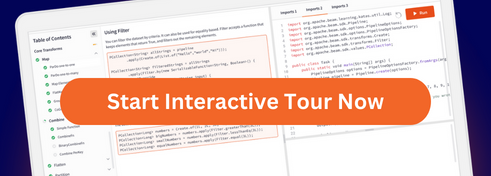使用 RunInference 与 Sklearn
|
以下示例演示了如何创建使用 Beam RunInference API 和 Sklearn 的管道。
示例 1:Sklearn 无键模型
在此示例中,我们创建一个管道,该管道对无键数据使用 SKlearn RunInference 转换。
import apache_beam as beam
import numpy
from apache_beam.ml.inference.base import RunInference
from apache_beam.ml.inference.sklearn_inference import ModelFileType
from apache_beam.ml.inference.sklearn_inference import SklearnModelHandlerNumpy
sklearn_model_filename = 'gs://apache-beam-samples/run_inference/five_times_table_sklearn.pkl' # pylint: disable=line-too-long
sklearn_model_handler = SklearnModelHandlerNumpy(
model_uri=sklearn_model_filename, model_file_type=ModelFileType.PICKLE)
unkeyed_data = numpy.array([20, 40, 60, 90],
dtype=numpy.float32).reshape(-1, 1)
with beam.Pipeline() as p:
predictions = (
p
| "ReadInputs" >> beam.Create(unkeyed_data)
| "RunInferenceSklearn" >>
RunInference(model_handler=sklearn_model_handler)
| beam.Map(print))输出
PredictionResult(example=array([20.], dtype=float32), inference=array([100.], dtype=float32), model_id='gs://apache-beam-samples/run_inference/five_times_table_sklearn.pkl')
PredictionResult(example=array([40.], dtype=float32), inference=array([200.], dtype=float32), model_id='gs://apache-beam-samples/run_inference/five_times_table_sklearn.pkl')
PredictionResult(example=array([60.], dtype=float32), inference=array([300.], dtype=float32), model_id='gs://apache-beam-samples/run_inference/five_times_table_sklearn.pkl')
PredictionResult(example=array([90.], dtype=float32), inference=array([450.], dtype=float32), model_id='gs://apache-beam-samples/run_inference/five_times_table_sklearn.pkl')示例 2:Sklearn 有键模型
在此示例中,我们创建一个管道,该管道对有键数据使用 SKlearn RunInference 转换。
import apache_beam as beam
from apache_beam.ml.inference.base import KeyedModelHandler
from apache_beam.ml.inference.base import RunInference
from apache_beam.ml.inference.sklearn_inference import ModelFileType
from apache_beam.ml.inference.sklearn_inference import SklearnModelHandlerNumpy
sklearn_model_filename = 'gs://apache-beam-samples/run_inference/five_times_table_sklearn.pkl' # pylint: disable=line-too-long
sklearn_model_handler = KeyedModelHandler(
SklearnModelHandlerNumpy(
model_uri=sklearn_model_filename,
model_file_type=ModelFileType.PICKLE))
keyed_data = [("first_question", 105.00), ("second_question", 108.00),
("third_question", 1000.00), ("fourth_question", 1013.00)]
with beam.Pipeline() as p:
predictions = (
p
| "ReadInputs" >> beam.Create(keyed_data)
| "ConvertDataToList" >> beam.Map(lambda x: (x[0], [x[1]]))
| "RunInferenceSklearn" >>
RunInference(model_handler=sklearn_model_handler)
| beam.Map(print))输出
('first_question', PredictionResult(example=[105.0], inference=array([525.]), model_id='gs://apache-beam-samples/run_inference/five_times_table_sklearn.pkl'))
('second_question', PredictionResult(example=[108.0], inference=array([540.]), model_id='gs://apache-beam-samples/run_inference/five_times_table_sklearn.pkl'))
('third_question', PredictionResult(example=[1000.0], inference=array([5000.]), model_id='gs://apache-beam-samples/run_inference/five_times_table_sklearn.pkl'))
('fourth_question', PredictionResult(example=[1013.0], inference=array([5065.]), model_id='gs://apache-beam-samples/run_inference/five_times_table_sklearn.pkl'))最后更新于 2024/10/31
你找到了你需要的一切吗?
它们是否有用且清晰?是否有任何你想更改的内容?请告诉我们!




 Pydoc
Pydoc